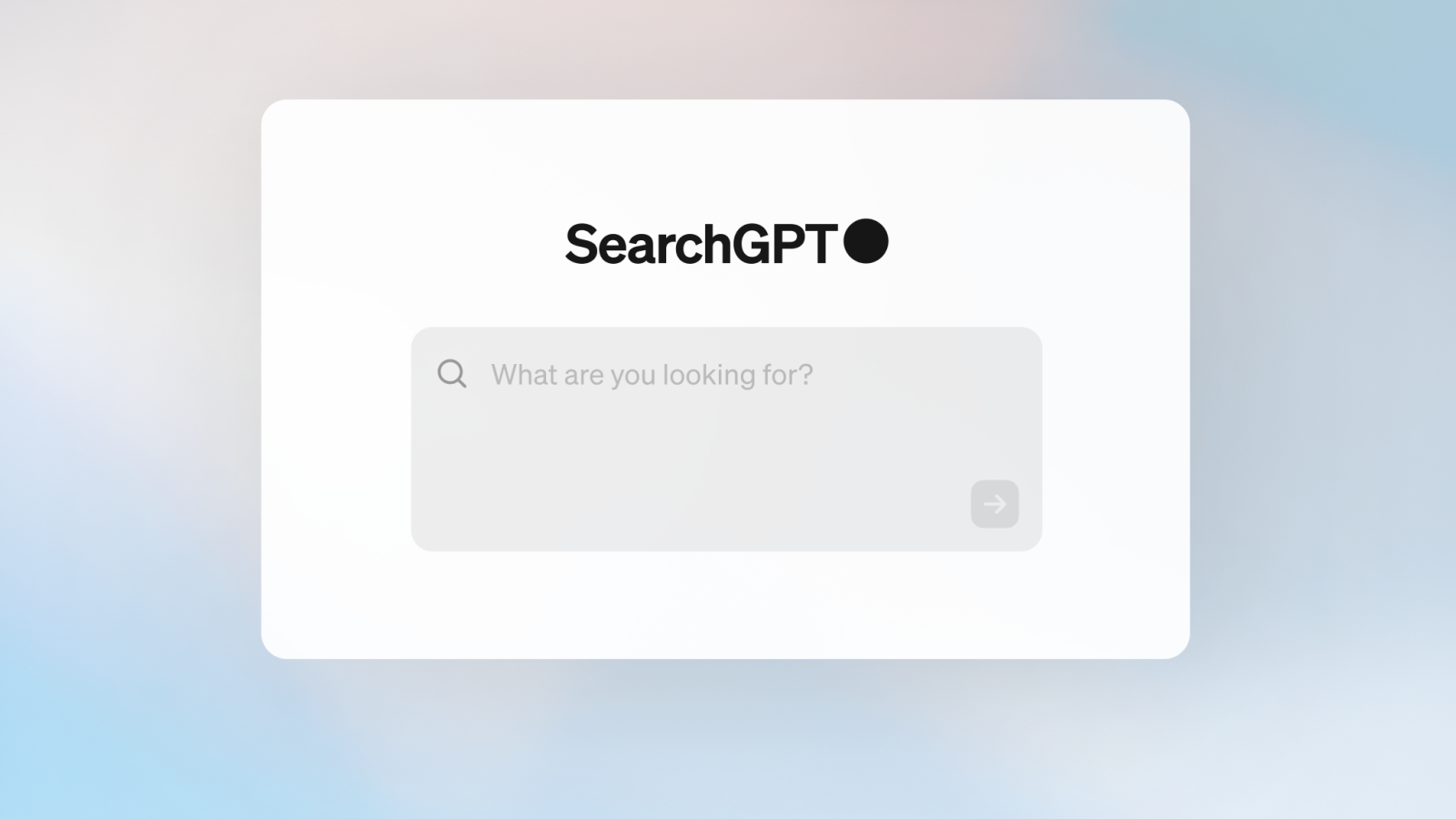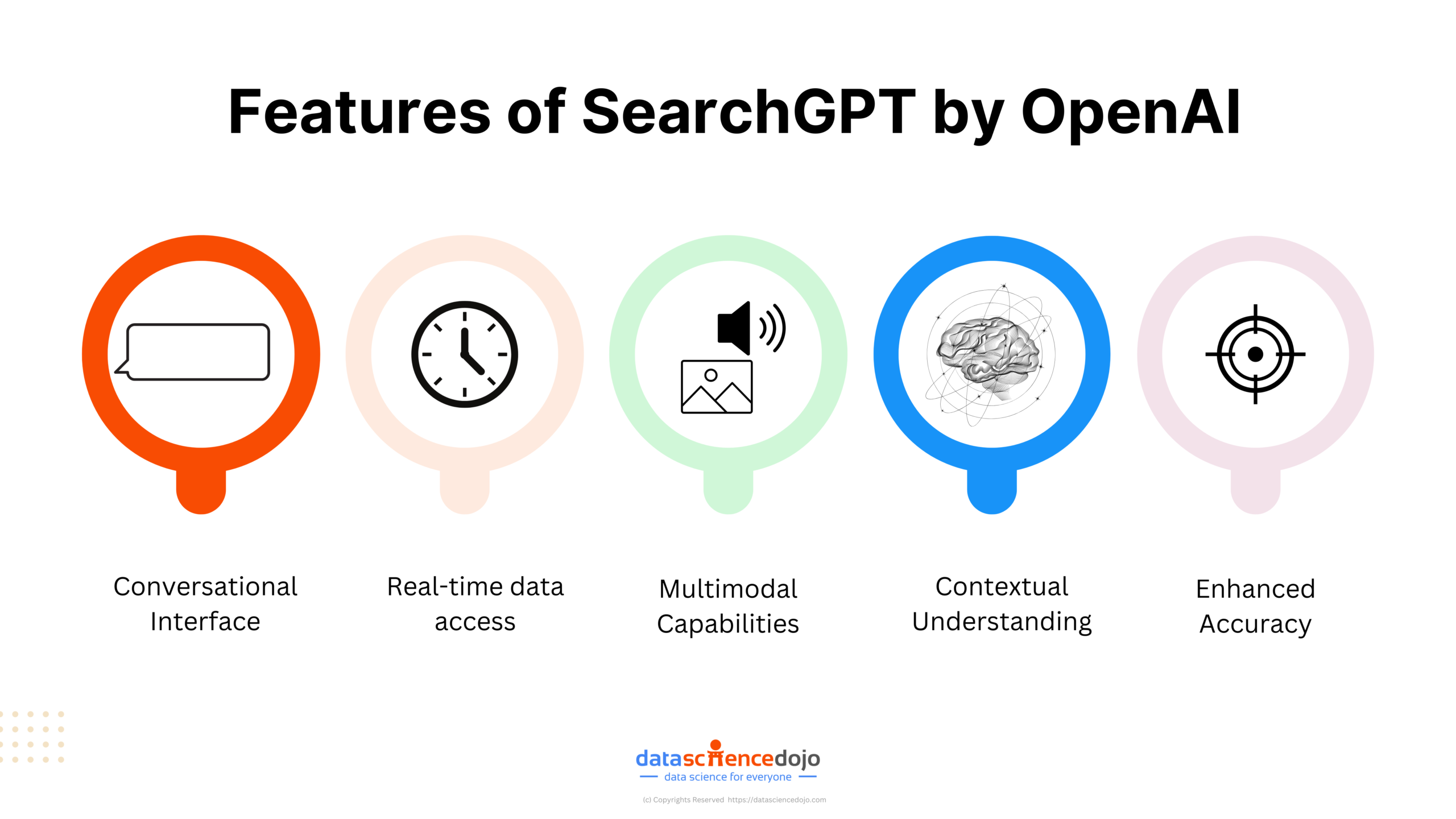The search engine landscape is on the brink of a major shift.
Traditional search engines like Google have dominated the field for years, but now OpenAI is entering the game with SearchGPT. This AI search engine promises to completely change how we find information online.
By understanding natural language queries and offering direct answers, SearchGPT transforms the search experience from a static list of links to an engaging dialogue.
This innovation could challenge the long-standing search monopoly, offering users a more interactive and efficient way to access real-time, accurate information. With SearchGPT, the future of search is here.
What is SearchGPT?
SearchGPT is an AI-powered search engine developed by OpenAI, designed to provide a more conversational and interactive search experience.

Announced on July 25, 2024, SearchGPT shifts from traditional keyword-based searches to understanding natural language queries, enabling users to ask follow-up questions and refine their searches dynamically.
An Example of How OpenAI’s AI-Powered Search Engine Works:
Imagine a user asking, “What are the best tomatoes to grow in Minnesota?” SearchGPT responds with a direct answer, such as “The best tomato varieties to grow in Minnesota include ‘Early Girl’, ‘Celebrity’, and ‘Brandywine’,” along with citations and links to sources like “The Garden Magazine”.
The user can then ask follow-up questions like, “Which of these can I plant now?” and receive a context-aware response, enriching the search experience by offering real-time, accurate information.
Google’s search engine is the most sophisticated machine humanity has ever built, but I think there are certain things that can be done better. Specifically, you can save a lot of time when you don’t have to sift through 10 links and do a lot of the manual work yourself – Denis Yarats, Co-Founder and CTO at Perplexity AI
Also read about: AI Powered Document Search
Features of SearchGPT

- Direct Answers: Instead of providing a list of links like traditional search engines, SearchGPT delivers direct answers to user queries.
- Relevant Sources: The answers are accompanied by clear citations and links to the source material, ensuring transparency and accuracy.
- Conversational Search: SearchGPT enables users to engage in a dialogue with the search engine, allowing for follow-up questions and a more interactive search experience.
- Real-Time Data: It leverages real-time data from the web to provide up-to-date information.
- Maintains Context: It maintains context across multiple interactions, allowing for a more personalized experience, and draws on real-time data for timely responses.
How Does OpenAI’s AI Search Engine Work?
SearchGPT is powered by sophisticated language models from the GPT-4 family. These models enable the search engine to understand the intent behind user queries, even if they are not phrased perfectly or use ambiguous terms. This allows it to provide more contextually relevant results.
Also learn how GPT-4 is stepping towards AGI
SearchGPT Vs. Google
Traditional search engines like Google and Bing primarily relied on keyword matching, which can sometimes lead to irrelevant or less helpful results, especially for complex or nuanced queries. Here’s how search GPT is going to be different from them.
- Real-Time Data Access:
- Unlike traditional search engines that rely on periodically updated indexes, SearchGPT uses real-time data from the web. This ensures that users receive the most current and accurate information available.
- Conversational Interface:
- SearchGPT employs a conversational interface that understands natural language questions, allowing users to interact with the search engine as if they were having a dialogue with a knowledgeable assistant.
- This interface also supports follow-up questions, maintaining context across multiple interactions for a more personalized experience.
- Direct Answers with Source Attribution:
- Instead of providing a list of links, SearchGPT delivers direct answers to user queries. It summarizes information from multiple sources, clearly citing and linking to these sources to ensure transparency and allow users to verify the information.
- Visual and Multimedia Integration:
- SearchGPT includes features like “visual answers,” which enhance the search results with AI-generated videos or multimedia content. This makes the information more engaging and easier to understand, although specific details on this feature are still being clarified.
How Does SearchGPT Compare to Other AI Tools
SearchGPT vs. AI Overviews
Similarities:
- AI-Powered Summarization: Both SearchGPT and AI Overviews use artificial intelligence to summarize information from multiple sources, providing users with a condensed overview of the topic.
- Direct Answers: Both tools strive to offer direct answers to user queries, saving users time and effort in finding relevant information.
Differences:
- Source Attribution: It prominently cites sources with direct links to the original content, enhancing transparency. AI Overviews, while providing links, might not have as clear or direct attribution to the claims made.
- Conversationality: It allows for dynamic interactions with follow-up questions and context retention, making the search experience more interactive. AI Overviews typically offer a single summarized response without interactive dialogue.
Another interesting read: Reverse Image Search
- Scope and Depth: It aims to offer comprehensive answers drawn from a wide range of sources, potentially including multimedia. AI Overviews focus on key points and guiding links for further exploration.
- Transparency/Control: It provides more transparency and control to publishers regarding how their content is used, including the option to opt out of AI training. AI Overviews are less transparent in their content selection and summarization processes.
SearchGPT vs. ChatGPT
Similarities:
- Conversational Interface: Both SearchGPT and ChatGPT use a conversational interface, allowing users to interact through natural language queries and follow-up questions, making both tools user-friendly and intuitive.
- Foundation: Both tools are built on OpenAI’s advanced language models, providing them with powerful natural language understanding and generation capabilities.
Differences:
- Primary Purpose: SearchGPT is designed specifically for search, prioritizing real-time information retrieval, and concise answers with source citations. ChatGPT, on the other hand, is focused on generating text responses and handling a wide range of conversational tasks.
- Information Sources: It relies on real-time information from the web, ensuring up-to-date responses. ChatGPT’s knowledge is based on its training data, which may not always be current.
OpenAI has entered cybersecurity with the launch of FraudGPT—click here to learn more.
- Response Format: It provides concise answers with clear citations and source links, while ChatGPT can generate longer text responses, summaries, creative content, code, and more.
- Use Cases: It is ideal for fact-finding, research, and tasks requiring current information. ChatGPT is suitable for creative writing, brainstorming, drafting emails, and other open-ended tasks.
SearchGPT vs. Perplexity
Similarities:
- AI-Powered Search: Both SearchGPT and Perplexity use AI to enhance search capabilities, making the process more intuitive and conversational.
- Conversational Interface: Both platforms allow users to refine their queries and ask follow-up questions in a conversational manner, providing a dynamic search experience.
- Source Attribution: Both emphasize citing and linking to original sources, ensuring transparency and enabling users to verify information.
Differences:
- Underlying Technology: SearchGPT is based on OpenAI’s language models like GPT-4, while Perplexity uses a combination of large language models (LLMs) and traditional search engine technologies.
- Interface: It may prioritize a streamlined interface with direct answers and concise information. Perplexity offers a visually rich interface with suggested questions and related topics.
- Focus: It is geared towards general knowledge and real-time information. Perplexity caters to researchers and academics, providing citation support and access to scholarly sources.
- Integrations: It plans to integrate with ChatGPT, enhancing its conversational capabilities. Perplexity may offer integrations with various research tools and platforms.
What Will be the Impact of AI Search Engine
The shift towards AI-powered, conversational search engines like SearchGPT represents a significant transformation in how we interact with information online.
While it offers numerous benefits, such as improved user experience and real-time data access, it also poses challenges that need to be addressed, particularly for publishers, ethical bodies, and privacy concerns.
The ongoing collaboration between OpenAI and various stakeholders will be crucial in navigating these changes and ensuring a balanced and beneficial ecosystem for all involved.
1. Publishers and Content Creators
- Traffic and Revenue: While SearchGPT aims to direct users to original sources, there are concerns about how direct answers might impact click-through rates and revenue models. OpenAI is actively working with publishers to address these concerns and support a thriving content ecosystem.
- Content Management: Publishers have control over how their content is used by SearchGPT, including the ability to opt out of being crawled for indexing or gathering training data.
- Collaboration Benefits: By collaborating with OpenAI, publishers can ensure their content is accurately represented and attributed, potentially increasing their visibility and credibility.
2. Search Engine Market
- Increased Competition: The introduction of SearchGPT adds a new competitor to the search engine market, challenging the dominance of established players like Google. This competition is likely to drive further innovation in the industry, benefiting users with more advanced search capabilities.
- AI Integration: Traditional search engines may accelerate their development of AI features to remain competitive. For example, Google is likely to enhance its AI Overviews and conversational capabilities in response to SearchGPT.
3. Researchers and Academics
- Access to Information: For those conducting in-depth research, tools like SearchGPT can provide more comprehensive answers and transparent sourcing, making it easier to access and verify information.
- Efficiency: The ability to engage in a dialogue with the search engine and receive personalized responses can streamline the research process, saving time and effort.
4. Ethical and Regulatory Bodies
- Bias and Misinformation: AI-powered search raises important ethical considerations, such as potential biases in AI-generated results and the spread of misinformation. Regulatory bodies will need to ensure that these systems are transparent and accountable.
- Privacy Concerns: There are also privacy implications related to tracking and analyzing user behavior. Ensuring that user data is handled responsibly and securely will be crucial.
What is the Way Forward?
As we embrace this leap in search technology, SearchGPT stands at the forefront, offering a glimpse into the future of information retrieval. It promises not only to make searching more efficient but also to foster a more engaging and personalized user experience. With its ability to understand and respond to complex queries in real-time, SearchGPT is poised to reshape our digital interactions, proving that the future of search is not just about finding information but understanding and conversing with it.





